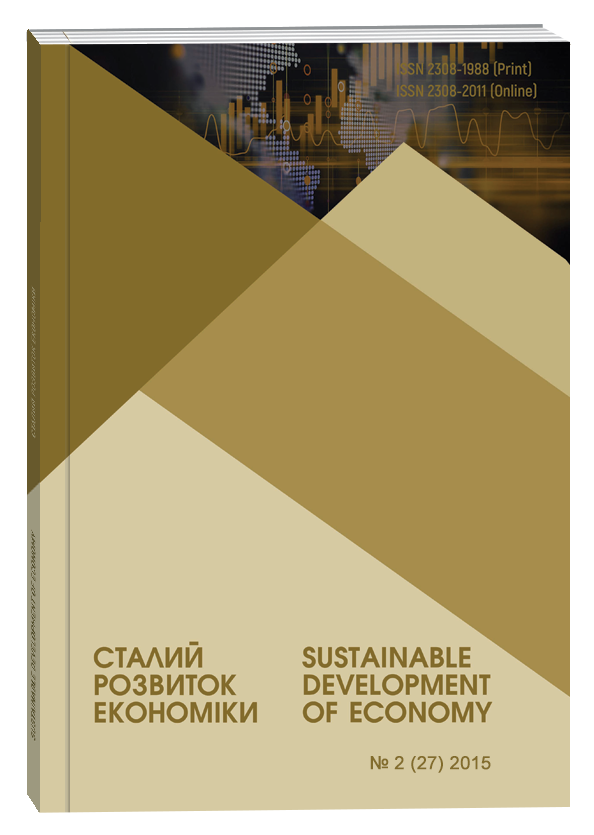HOUSEHOLD SAVINGS: ECONOMIC NATURE AND FACTORS OF IMPACTS
Abstract
Purpose – identify the main theory about the nature of savings. On this basis, to isolate the main factors influencing the ratio of consumption-savings in the structure of household costs. Methodology of research. The theoretical basis for this research is scientific works our and foreign scientists regarding this question. General scientific methods were used in the process of research: structural and logical, generalization, dialectical (reasoning of the saving nature and savings motives), system (substantiation of the need for research the impact of savings on the state's economy), comparative (determination of basic scientific approaches that describe the nature of savings) Findings. The main provisions of the theories about the nature of savings was considered. Shows the main reasons that motivate people to save, including basic is desire to increase own capital of population. Households in a market economy is the subject of the national economic system. Their savings can play an important role in economic development if transform them into investments. Promote this transformation has become a key task of the state in shaping investment strategy. Positive experience similar changes observed in Asian countries. There savings rate is very high. Originality. The nature of savings was improved. The essence is to use them as capital that is to increase revenue. This is a key point to consider savings as investment resources at the state level. Practical value. The analysis results provide a theoretical basis for the formation of effective investment policy at the macro level considering savings of population.
References
Ando A. The «Life Cycle» Hypothesis of Saving: Aggregate Implications and Tests / A. Ando, F. Modigliani // The American Economic Review. – 1963. – Vol. 53. – No. 1. – Part 1. – pp. 55-84.
Inflation and the Consumer / [Juster F.T., Wachtel P., Hymans S., Duesenberry J.] // Brookings Papers on Economic Activity. – 1972. – Vol. 1972. – No. 1. – pp. 71-121.
Friedman M. Utility Analysis of Choices Involving Risk with Leonard Savage / M. Friedman // Journal of Political Economy. – 1948. – No. 4. – Vol. 56. – pp. 38-47.
Бандера В. Доходи та заощадження в перехідній економіці України / [Бандера В., Буняк В.Б., Ватаманюк З.Г. та ін.] ; за ред.: С. Панчишин, М. Савлук. – Львів : Львівський нац. ун-т ім. І. Франка, 2003. – 406 с.
Ватаманюк О.З. Заощадження в економіці України: макроекономічний аналіз : [монографія] / О.З. Ватаманюк. – Л. : ЛНУ ім. І. Франка, 2007. – 536 с.
Кейнс Дж.М. Общая теория занятости, процента и денег / Дж.М. Кейнс. – М. : Прогресс, 1992. – 520 с.
Кізима Т.О. Заощадження домашніх господарств: сутнісно-теоретичні та класифікаційні аспекти / Т.О. Кізима // Формування ринкових відносин в Україні. – 2010. – № 10. – С. 200-206.
Луценко А.В. Сбережения работающего населения: Масштабы, функции, мотивы / А.В. Луценко, В.В. Радаев // Вопросы экономики. – 1996. – № 1. – C. 12-18.
Смит А. Исследования о природе и причинах богатства народов / А. Смит // Классика экономической мысли: сочинения. – М. : Изд-во ЭКСМО-Пресс, 2000. – 371 с.
Ходжсон Дж. Институты и индивиды: взаимодействие и эволюция / Дж. Ходжсон // Вопросы экономики. – 2008. – № 8. – С. 45-60.
Шевалдіна В.Г. Вплив доходів населення на формування заощаджень / В.Г. Шевалдіна // Фінанси, облік і аудит. – 2011. – Вип. 17. – С. 201-208.
Шохин А.Н. Денежные сбережения населения как экономическая категория / А.Н. Шохин. – М. : ЦЭМИ АН СССР, 1984. – 123 с.
Янель Ю.А. Заощадження домогосподарств України та їх мотивація / Ю.А. Янель, К.О. Соломянова // Економіка. Фінанси. Право : [щомісячний інформаційно-аналітичний журнал]. – 2006. – № 6. – С. 9-13.
Ando, A. and Modigliani, F. (1963), “The «Life Cycle» Hypothesis of Saving: Aggregate Implications and Tests”, The American Economic Review, Vol.53, no.1, Part 1, pp. 55-84.
Juster, F.T, Wachtel, P., Hymans, S. and Duesenberry, J. (1972), “Inflation and the Consumer”, Brookings Papers on Economic Activity, Vol. 1972, no.1, pp. 71-121.
Friedman, M. (1948), “Utility Analysis of Choices Involving Risk with Leonard Savage”, Journal of Political Economy, no.4, Vol. 56, pp. 38-47.
Bandera, V., Buniak, V.B., Vatamaniuk, Z.H. et al. (2003), Dohody ta zaoshchadzhennia v perehidnii ekonomitsi Ukrainy [Income and savings in transition economies Ukraine], LNU im. Franka, Lviv, Ukraine, 406 p.
Vatamaniuk, O.Z. (2007), Zaoshchadzhennia v ekonomitsi Ukrainy: makroekonomichnyi analiz [The savings in the economy of Ukraine: macroeconomic analysis], monograph, LNU im. Franka, Lviv, Ukraine, 536 p.
Keins, Dzh.M. (1992), Obshchaia teoriia zaniatosti, protsenta i deneg [The General Theory of Employment, Interest and Money], Progress, Moscow, Russia, 520 p.
Kizyma, T.O. (2010), “Household savings: the theoretical aspects and classification”, Formuvannia rynkovykh vidnosyn v Ukraini, no. 10, pp. 200-206.
Lutsenko, A.V. and Radaev, V.V. (1996), “Savings of the working population: The scope, functions, motives”, Voprosy ekonomiki, no.1, pp. 12-18.
Smit, A. (2000), Issledovaniia o prirode i prichinakh bogatstva narodov [The Wealth of Nations], Izd-vo EKSMO-Press, Moscow, Russia, 371 p.
Khodzhson, Dzh. (2008), “Institutions and individuals: cooperation and evolution”, Voprosy ekonomiki, no.8, pp. 45-60.
Shevaldina, V.H. (2011), “The impact of household income on savings formation”, Finansy, oblik i audyt, iss.17, pp. 201-208.
Shohin, A.N. (1984), Denezhnye sberezheniia naseleniia kak ekonomicheskaia kategoriia [Cash savings of the population as an economic kategorіya], TSEMI AN SSSR, Moscow, Russia, 123 p.
Yanel, Yu.A. (2006), “Household savings Ukraine and their motivation”, Ekonomika. Finansy. Pravo, no.6, pp. 9-13.


